Mar Menor
Golf
Cartagena
Murcia
Further Inland
Sierra Espuña
Further Information
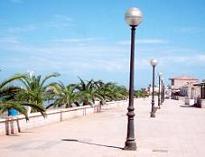 Mar Menor Promenade |
LocationMar MenorThe Costa Cálida (Warm Coast) stretches either side of Cartagena from the Mar Menor to Águilas. The Mar Menor, is a warm, shallow, saltwater lagoon in the Murcia region of Spain. It is ideal for swimming in all year round. The Mar Menor (literally the 'smaller' or 'lesser' sea) is on average 7m (22ft) deep, has an area of 170 sq km (65 sq miles) and is the largest coastal lagoon in Europe. It is located to the South East of Murcia in the South East of Spain. |
| The Mar Menor is separated from the open sea by a strip of land known as La Manga (the 'arm' or 'sleeve') which is only 22km (14 miles) long and no wider than 1500m (just under 1 mile). The reputed therapeutic quality of its salt content has visitors by the thousands coating themselves in the healing mud of the Mota de la Calcetera (close to Lo Pagan) every year. | |
|
In summer, the water in the Mar Menor, can be 5°C (9°F) warmer than the Mediterranean making it very popular with sailors and windsurfers. Indeed, the Mar Menor will fulfil your every need for beaches and watersports. Watersports are available all along The Strip. The Estación Náutica Mar Menor (Mar Menor Nautical Station) is a group of 20 watersports centres in the area offering sailing, windsurfing, canoeing courses and jet skiing. Visit www.enmarmenor.net for further details. |
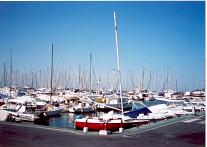 Tomas Maestre Marina |
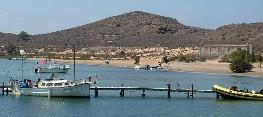 Island Boat Trip |
In the middle of the Mar Menor are five small volcanic islands, Isla mayor, La erdiguera (boat trips), El Ciervo (road link with La Manga), (El Sujeto and La Redondela). For a relaxing day or half day out, why not take a boat trip to one of the islands? |
Diving and snorkelling are also available, 30 minutes drive away at Cabo de Palos (Planeta Azul diving and outdoor activity centre www.planeta-azul.com). This is one of the best places in Europe for diving, due to its unusual marine geography. Here the continental shelf is so narrow, that there is an immediate drop and this coupled with the warm water, means it has one of the biggest abundances of marine life in the Western Mediterranean. There have been sightings of blue sharks, sperm whales and giant squid. Just to the south of Cabo de Palos, is the picturesque Calblanque Beach. |
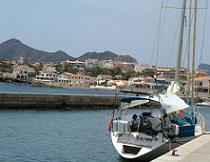 Cabo de Palos Fishing Village |
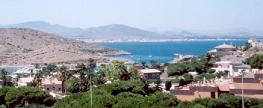 View across Mar Menor |
Further round the Mar Menor, are the older more typical resorts of Santiago de la Ribera and Los Alcazares. At Playa Mazanares in Los Alcazares, formerly a summer retreat for Moorish kings, wooden bathing platforms, built around the Mar Menor beaches in about 1900, are still visible. |
GolfGolf is very popular in the area. There are a range of courses nearby and of course there is the famous La Manga Club. |
CartagenaCartagena is really worth a visit, both for its history and its shopping. Cartagena, the second largest town in the region, was founded by the Carthaginians in 223BC. The Romans Byzantines and Arabs all took advantage of the perfect natural harbour, surrounded by mountains rich in ore. The city is also carrying out excavations in its old quarter to reveal its long-buried Roman and Carthaginian heritage.
The city's real character is in the old part of town down by the port, with its narrow medieval streets, packed with bars and restaurants. To get a feel of the city's distinguished past, wander along the sea wall towards the old military hospital. From the lighthouse there are great views of the harbour and city. For a great panorama of town and hills that embrace the harbour, make your way up to the Castillo de la Conception, enjoy the uphill walk or take the lift. The town remains the largest Spanish naval base on the Mediterranean. A way to view the city's fortresses and batteries, from the sea, is to take a trip in the 90-seat catamaran from the Paseo de Alfonso XII. |
MurciaThose who venture into Murcia are pleasantly surprised, the people are friendly and the culture is interesting. Murcia is the regional capital and an elegant university city on the river Segura. It was founded in 825 by the Moors, following successful irrigation of the surrounding fertile plain. Murcia boasts a modern spruced-up centre and a healthy cultural life. Though there are very few tourists, a substantial student population ensures that there is a lively bar and club scene. To explore the city, head for the Cathedral and then explore from there. |
Further InlandInland from Murcia, enjoy a day out in the Ricote valley, visiting the pretty villages of Abaran, Archena, Blanca, Cieza, Ojos, Ricote, Ulea and Villanueva del Rio Segura (www.valledericote.com). In the village of Blanca, there are still the remains of the Moorish castle. Archena, is a spa town that is famous among Spaniards and was founded by the Arabs. Its mineral rich waters pour out at 52°C and then cool to a health-giving 37°C (body temperature). A way to enjoy the waters, is to stay at one of the three spa hotels or opt for a day entry pass (Balneario de Archena Spa Treatments www.balneariodearchena.com). A little further inland is the picture-postcard town of Caravaca de la Cruz, crowned by a 15th Century castle reached by ancient cobbled streets. Caravaca de la Cruz is a holy city and one of the five 'Jubilee Cities' in the world along with Rome, Jerusalem, Santo Toribo de Liebana and Santiago de Compostela. The castle in Caravaca de la Cruz, houses the Santuario de la Vera Cruz (Sanctuary of the True Cross). This is where a double-armed cross is said to have miraculously appeared in 1231. The nearby Cehegin and Calsparra are also pretty towns. |
Sierra Espuña National Park |
|
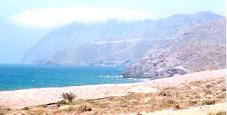 Sierra Espuña National Park |
Nature lovers will enjoy hiking through the National Park of Sierra Espuña, which offers spectacular scenery and wildlife. The sports on offer, include climbing, paragliding, orienteering and canoeing. (Sierra Espuña official website www.sierraespuna.com ). The park is also home to deer, wild boar, black vultures, golden eagles and the rare barbary sheep. |
Further Information On The RegionFor more information, contact the Spanish Tourist Office on +44 (0) 20 7486 8077 (UK) or visit www.spain.info. The tourist office of Murcia produces its own comprehensive English/Spanish language website www.murciaturistica.es which offers maps of every town in the region. |
|